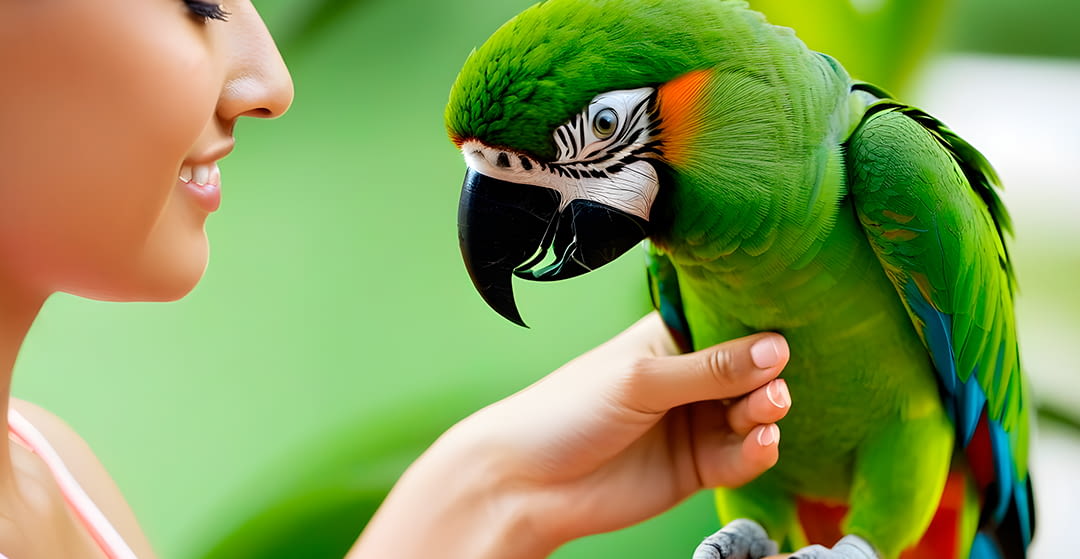
This article is based on parrots only, not birds in general. Not all species of birds enjoy physical contact, so before petting a bird we should know if its species has mutual grooming in its pattern or if it does not (like raptors).
Parrots, despite being sociable species that like to be petted, are not dogs or cats, so the way you touch them will be somewhat different, so first let's address the problems that may arise.
PROBLEMS THAT EXCESS OF TOUCH/TOUCH CAN CAUSE
Excessive cuddling and petting in parrots and cockatiels can eventually lead to medical and behavioral problems. The most common are: biting, excessive screaming, feather plucking, excessive egg laying, and cloacal prolapse in some species.
It is not clear whether excessive petting is always what causes this, but nevertheless, the risk should be enough to suggest that your customers change their behavior if they are giving excessive petting of this nature to their birds.
Generally, other species of parrots do not allow the same type of handling or petting that other species of cockatoos (Albas or Moluccas, especially) allow. This intolerance to touch can lead to conflict, as we have pointed out, since the birds become sensitive to the presence of hands and begin to show behaviors such as biting that increase the distance and that can be annoying for the owners.
WHERE, HOW AND WHEN SHOULD YOU TOUCH THE PARROTS?
The answer depends on each individual parrot and also the bird's environment, as each home, aviary, and keeper is different.
Generally, the place that birds are most frequently touched is the highest part of their head, preening the feathers in this area, and this preening will be more than appreciated, but not if it is forced.
In that head space, a favorite petting spot for many cockatoos is under the crest, just above the head where species like the Albas or Moluccas have a bald area.
You should always observe body language to know if the parrot invites head scratching or body contact, since, like us, they may not always be in the mood to be touched or pampered.
Body language that can be seen as saying “no” could be moving their head away from the hand and turning it to the side, flattening their backs with their wings away from their body, raising their tail and opening and closing their cloaca. sewer, if so, you have to pay attention to that requirement, move your hand away and try again later.
Additionally, if birds are exhibiting mating behaviors, hugging or petting should be avoided altogether. In these cases, the types of body language to pay attention to are:
. In the case of cockatoos: crouching, gasping or shaking with ecstasy (sometimes mistaken for an attack).
. In the case of macaws: opening and closing of the cloaca, high tail or squatting position with a flattened back.
If this is observed, petting and touching should be avoided and the bird redirected to some other activity.

Becoming familiar with this body language to get to know the bird better is essential since invitations to groom also appear, which would be the parrot lowering its head, exposing its forehead and perhaps touching itself under its neck with a paw.
As for hugs or other cuddles, it must be kept in mind that these must be short and not intense as is done with dogs or cats.
In fact, it is important to be skilled in handling birds to prepare them for veterinary exams or for the owner to examine them in case of injury.
IN CONCLUSION
Taking into account what we have pointed out, these are the areas where you can and cannot touch the parrot:
· HEAD: the head is the area where it is most appropriate to touch them. They enjoy grooming their head and neck, simulating social behavior among individuals in the flock.
· BACK: stroking a female on the back is stimulating her to reproduce, since it is the behavior that the male performs before mounting her. We should avoid that area, as it could lead to egg laying and frustration.
· TAIL: like the back, handling the tail is a copulatory behavior, therefore it is not advisable to touch it either.
· PAWS: the paws are an authorized area to be touched, but not all parrots like it and there is a risk of bite. You can touch them only if there is complete trust.
· CHEST AND ABDOMEN: although it is not a "prohibited" area, they are vulnerable areas of the animal and they do not usually enjoy caressing those areas.
· WINGS: caresses under the wings are a manifestation of courtship, therefore they should be avoided.



